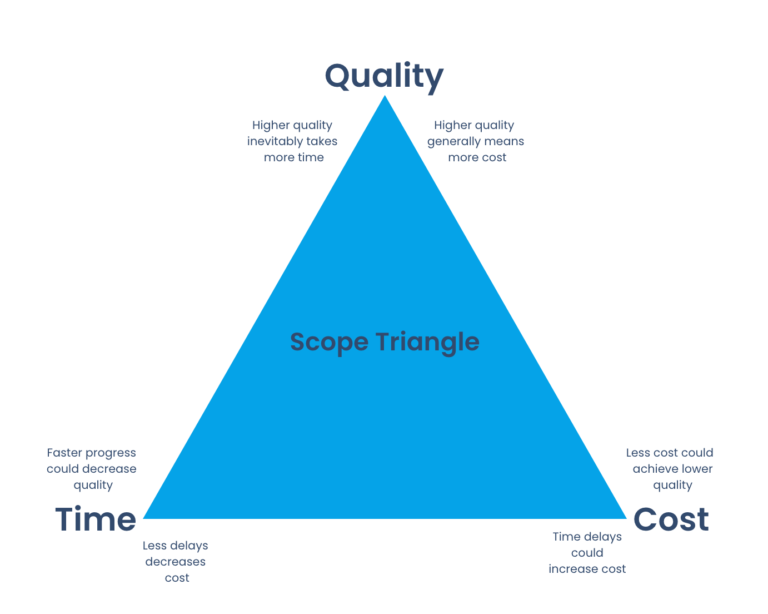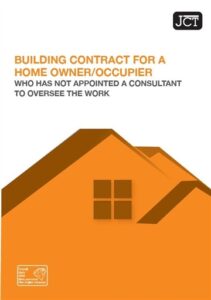our aim is to create happy customers by
Manageing customer expectations
As a professional building and maintenance company our aim is to do an excellent job and keep customers happy. But it is well known that disagreements can arise between the customer and the service provider. These disagreements usually are about Cost, Quality or Time.
Examples are that a job may go over time due to additional structural works are required to an old building being refurbished that was unknown to all in the beginning. This may also increase the cost of the job. Quality is not effected in this case. This factor was not included in the original quotation as it was unknown until the building fabric was exposed. The building company cannot absorb these costs and they must be passed on to the customer. This is why transparency and good communication is essential between the client and those providing the service.

Understanding the scope triangle for your project
The triangle illustrates the relationship between three primary forces in a project. Time is the available time to deliver the project, cost represents the amount of money or resources available and quality represents the fit-to-purpose that the project must achieve to be a success.
The normal situation is that one of these factors is fixed and the other two will vary in inverse proportion to each other. For example time is often fixed and the quality of the end product will depend on the cost or resources available. Similarly if you are working to a fixed level of quality then the cost of the project will largely be dependent upon the time available (if you have longer you can do it with fewer people).
A multitude of factors can effect the scope triangle.
other factors to understand
Build cost estimating and how we accurately price work
When calculating build cost we cross reference three sets of data.
- We use national build cost estimation software and platforms which provide realtime up to date national build cost data specific to the location. This data is derived from thousands of data inputs extracted from real current building projects across the country.
- We use our own data from passed projects and work packages of similar scope. From experience we know that building work with high levels of constraints (i.e. difficult access) will increase costs accordingly. Cost can also be cross referenced with other building partners.
- On larger projects we will use the service of professional build cost estimators.
Here are just a few examples of build projects we have completed which we have experience and data.
- Loft conversion, additional storeys and extending upwards
- House new builds
- Garage conversion & out buildings
- House extension
- Office & commercial buildings to residential apartments
- Refurbishments
- Pub conversion to residential
what is a provisional sum = estimates
Within your quote for building or maintenance works you may have a item labelled as an estimate or provisional sum.
This item we do not know the exact cost of so we will make a “best guess” based on experience or industry standards.
But the cost is still unknown.
Examples of situations that might involve provisional sums might include:
- Uncertainties relating to ongoing undefined scope of works (i.e. scope creep)
- Earthworks where it has not been possible to carry out thorough ground investigations.
- Where works cannot be known until an existing structure is opened up or removed.
- Where innovative or specialist work is impossible to accurately price in advance.
- The amount and type of waste material a project creates.
What is a prime cost sum = A rough know cost of an item
A prime cost sum is basically a rough known cost of an item or package of works from say an electrician.
The item could be double glazed bi-folding doors and the price was retrieved from a range of online providers.
Not until the item is purchased and fitted was the true price known.
Examples of a situation that might involve a prime cost sum might include:
- Doors with different quality specifications with a 50% price variation up or down.
- Electricians and other sub-contractor specialists quotes.
- Sanitary items, light fixtures, tiles etc. all with variations in installation cost but a mean average is known.
Handling cost: Why good communication is needed between the client and the contractor
EXAMPLE: On one project I was involved with the client had order a very expensive bespoke free standing bath tub. Unknown to all managing the job this bath was delivered to the site and offloaded onto the pavement outside the house. No communication from the client had taken place to inform us of its delivery. Worse still the delivery happened at the end of the working day when most persons on the site had finished for the day. The bath was delivered in a wooden crate and weighed in excess of 300kg. Due to the very high cost of the item, its ease to being damaged and the very heavy weight and limited gripping points and space to move it in the house it presented a very difficult task just to move. This bath had also to be lifted up two flights of tight stars to the bathroom. This task took five very strong tradesmen exerting great effort to do the task. These tradesmen had to all be persuaded to return to the site to complete this task so the bath was not left on the street overnight. All these tradesmen had to be paid for their time and for the risk of injury which could have put them out of work. This cost had to be met by the client.
Contracts: We use professional contracts such as JCT
We use construction industry professional standard contracts to give both parties peace of mind that professional business standards are being applied and that your project is managed in the highest professional manner.
SEE link to the JCT family of contracts.

